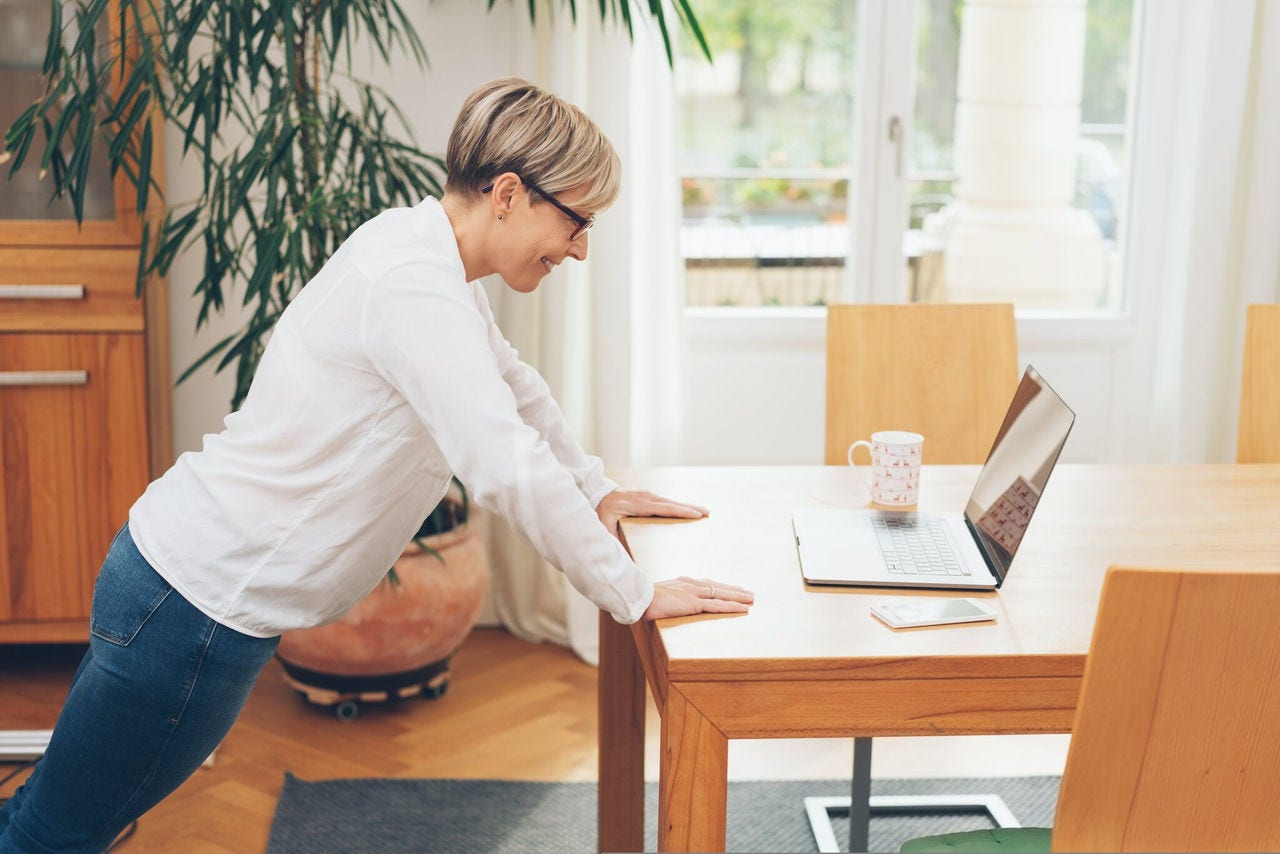Exercising at Your Desk or at Home
Exercising doesn’t have to mean joining a gym or buying workout gear. You can get physically active anywhere, even at your desk.
Regular exercise can improve your health and lower your risk of several types of cancer. It can also boost your energy and help you move more easily. The American Cancer Society recommends getting at least 150 minutes of moderate activity or 75 minutes of vigorous activity a week.
There are many ways to include physical activity in your daily routine.

Exercising at your desk
If you sit at a desk for your job, it’s important to build movement breaks into your workday. You can even do exercises at your desk.
Sitting for a long time without breaks can put you at risk for cardiac problems, excess weight, diabetes, muscle weakness, neck and back pain, and blood clots in your legs. It has also been linked to poor sleep.
Moving during the day could lower your risk of these health problems and help you sleep better, feel better, and enjoy a greater sense of well-being.
Desk exercise ideas
There are many exercises you can do with your desktop and a chair.
Squats
Stand about a foot away from your desk with your feet shoulder-distance apart and toes a little outward. With your chest and head up, push your hips back, placing your weight on your heels as you lower your body like you are about to sit on a chair.
When you reach the level of the squat you want, push through your legs to straighten your body back to a standing position. Repeat this process 10 times, rest for 15 to 30 seconds, then repeat it again 10 times. This would be 2 sets of 10 squat reps.
Standing bicycle crunches
Stand with your feet shoulder-distance apart. Engage your core muscles and bend one elbow to touch the opposite knee while bending that knee up. Repeat this with the other elbow to touch the opposite knee.
Repeat this with each side until you complete 20 (10 each side). Rest 15 to 30 seconds and repeat. This would be 2 sets of 20 bicycle crunch reps.
Neck stretches
Sit up tall and lean your head to one side, bringing your ear toward one shoulder. Hold this position for 10 seconds, then release. Repeat on the other side for 10 seconds.
Arm circles
Lift both arms up and away from your body, parallel to the floor. Make small circles with your arms toward the front for a count of 10. Then do small backward circles with your arms for a count of 10. Rest for 15 seconds and repeat.
Desk pushups
Make sure your desk is stable and doesn’t have wheels. Then place both hands on the desk, shoulder-distance apart. Take 5 to 8 steps back (maybe more if needed) until you are leaning toward the desk. Bend your elbows to lower yourself down until your elbow is bent at a 90-degree angle, then press through your hands to come back up. Do this 10 times. Rest for 15 seconds and repeat.
Lats stretch
Stand by your desk and lift one arm up and over your head, like you’re reaching for something. Hold this position for 30 to 60 seconds. Release. Repeat with the other side.
Using a sit-stand desk
Some workplaces have standing desk options, called a sit-stand desk. You can also have one at home. These desks give you the choice to sit or stand by pressing a button or lever to raise the desktop to your standing position. You can use a walking pad or mini stepper at your desk for physical activity.

Exercising at home
Exercising at home can give you just as many benefits as exercising in a gym. You can use equipment like dumbbells or resistance bands, but you don’t have to. There are lots of ways to get active at home without equipment.
These at-home exercises can include cardio, weight training, and mobility. You can build an exercise plan that’s doable and fits into your daily activities.
Ideas for physical activity around the house
Housework, yard work, and daily chores all count as physical activity. It adds up! Some examples include:
- Vacuuming
- Sweeping
- Mopping
- Walking up and down stairs
- Mowing the yard
- Yardwork, like raking leaves or pulling weeds
- Housework, like dusting furniture or re-organizing the garage
Exercise snacking
Doctors often prescribe exercise “snacking” as a way to move more and sit less throughout the day.
Exercise snacking = Exercising for a short period of time, a few times each day. Repeated a few days each week.
This might look like:
- Morning exercise snack: 10 squats, rest for 30 seconds, do 10 more squats
- Afternoon exercise snack: 10 pushups, rest for 30 seconds, do 10 more pushups
- Do this every Monday, Wednesday, and Friday.
You can always add more exercises to your snack breaks. Or if you need to start with less, you can do 1 set of squats instead of 2. You have the option to slowly increase your exercise snacking over a period of a few weeks.
Ideas for exercise snacking
Exercises you can do as part of “snacking” include:
- Plank holds
- Crunches
- Squats
- Jumping jacks
- Pilates for core strength
- High-intensity interval training
- Dancing
- Chair workouts
- Treadmill
- Kettlebell or dumbbell workouts
You can include other at-home workouts to go along with your exercise snacks. Just make sure you set realistic expectations that you can measure. For example, “I plan to do exercises at home for 20 minutes, 3 days a week.”
You can combine your own exercises for a full workout or follow a plan, like online classes through a local gym or with a fitness trainer.
Tips for getting started
Exercising at home or at your desk is a great way to stay active and break up the amount of time you spend sitting. Regular movement can improve your health, help you reduce stress, and give you a sense of well-being.
To help you get active and exercise safely:
Always warm up and cool down. Be sure to include warmups before you exercise. Plan to spend about 5 minutes on warmups like stepping in place, arm circles, or hip circles. This loosens your muscles and gets your heart rate up. After your workout, do a cool-down to stretch your muscles and lower your heart rate.
It’s okay to start small. Even if you don’t do enough to get 150 minutes of physical activity to meet the recommendations, doing some movement is better than none.
Track your time. Set a timer to track how long you spend exercising. If you do these activities regularly, it could add up to the total number of recommended minutes each week.
Change your workout to fit your needs. Remember, you can change your workouts to fit what you can and want to do. This might mean decreasing or increasing the number of strength exercises, changing up your equipment, or increasing the intensity.
Be consistent. Do exercises on a regular basis. This is important to see and feel results.
Listen to your body. If you have pain while exercising, stop and follow up with a health care provider. If you have any questions or concerns about exercise, talk with your health care provider.
Learn more
- Written by
- References

The American Cancer Society medical and editorial content team
Our team is made up of doctors and oncology certified nurses with deep knowledge of cancer care as well as editors and translators with extensive experience in medical writing.
American College of Sports Medicine. Physical activity guidelines. 2025. Accessed at https://acsm.org/education-resources/trending-topics-resources/physical-activity-guidelines/ on September 25, 2025.
Rock CL, Thomson C, Gansler T, et al. American. Cancer Society guideline for diet and physical activity for cancer prevention. CA Cancer J Clin. 2020;70(4). doi:10.3322/caac.21591. Accessed at https://onlinelibrary.wiley.com/doi/full/10.3322/caac.21591 on August 13, 2025.
Boyle JT, Nielson SA, Perlis ML, Dzierzewski JM. Move your feet and sleep: A longitudinal dynamic analysis of self-reported exercise, sedentary behavior, and insomnia symptoms. Sleep Health. 2024;10(3): 321-326. https://doi.org/10.1016/j.sleh.2024.02.005
Deery E, Buckley J, Morris M, Kennedy L. “Some people sit, some people stand, that’s just what we do”: a qualitative exploration of sit-stand desk use in naturalistic settings. Occup Health Sci. 2024 Sep;8(3):505-31. https://link.springer.com/article/10.1007/s41542-024-00176-0
Nuzzo, JL., Pinto, MD, Kirk BJC, Kazunori N. Resistance exercise minimal dose strategies for increasing muscle strength in the general population: an overview. Sports Med 54, 1139–1162 (2024). https://doi.org/10.1007/s40279-024-02009-0
Rock CL, Thomson C, Gansler T, Gapstur SM, Gapstur SM, McCullough ML, Patel AV, et al. American Cancer Society guideline for diet and physical activity for cancer prevention. CA: A Cancer Journal for Clinicians. 2020;70(4. Accessed at https://acsjournals.onlinelibrary.wiley.com/doi/full/10.3322/caac.21591 on August 25, 2025.
Rogers EM, Banks NF, Trachta ER, Barone Gibbs B, Carr LJ, Jenkins NDM. Acceptability of performing resistance exercise breaks in the workplace to break up prolonged sedentary time: A randomized control trial in U.S. office workers and students. Workplace Health & Safety. 2024;72(6):234-243. doi:10.1177/21650799231215814
Last Revised: October 24, 2025
American Cancer Society medical information is copyrighted material. For reprint requests, please see our Content Usage Policy.
American Cancer Society Emails
Sign up to stay up-to-date with news, valuable information, and ways to get involved with the American Cancer Society.



